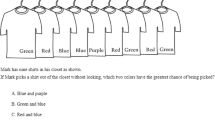Abstract
Sixty-one children, from 4 to 11 years old, were presented with two sets, each containing blue and yellow elements. Each time, one colour was pointed out as the payoff colour (POC). The child had to choose the set from which he or she would draw at random a POC element in order to be rewarded. The sets were of varying sizes with different proportions of the two colours. The problem was to select the higher of the two probabilities. Three kinds of materials were used: Pairs of urns with blue and yellow beads, pairs of roulettes divided into blue and yellow sectors, and pairs of spinning tops, likewise divided into two colours.
Roughly around the age of six, children started to select the greater of the two probabilities systematically. The dominant error was selecting the set with the greater number of POC elements. Verbal concepts of probability and chance were explored and some ‘egocentric’ thought processes were described. The study indicates that probability concepts could be introduced into school teaching even in the first grades. The deterministic orientation in the instruction for young ages should be attenuated, permitting concepts of uncertainty right from the beginning.
Similar content being viewed by others
References
CarlsonJ. S.: 1970, ‘The development of probabilistic thinking in children: a comparison of two methods of assessment,’ The Journal of Genetic Psychology 116, 263–269.
ChapmanR. H.: 1975, ‘The development of children's understanding of proportions’, Child Development 46, 141–148.
DaviesC. M.: 1965, ‘Development of the probability concept in children,’ Child Development 36, 779–788.
FischbeinE.: 1975, The Intuitive Sources of Probabilistic Thinking in Children, Reidel, Dordrecht-Holland, pp. 66–98.
FischbeinE., PampuI. and MânzatI.: 1970, ‘Comparison of ratios and the chance concept in children,’ Child Development 41, 377–389.
GoldbergS.: 1966, ‘Probability judgments by preschool children: Task conditions and performance,’ Child Development 37, 157–167.
HoemannH. W. and RossB.: 1971, ‘Children's understanding of probability concepts,’ Child Development 42, 221–236.
PiagetJ.: 1952, The Child's Conception of Number, Routledge and Kegan Paul, London, pp. 3–38.
PiagetJ. and InhelderB.: 1951, La Genèse de l'Idee de Hasard chez l'Enfant, Presses Univer. France, Paris.
YoustP. A., SiegelA. E. and AndrewsJ. M.: 1962, ‘Nonverbal probability judgments by young children,’ Child Development 33, 769–780.
Author information
Authors and Affiliations
Rights and permissions
About this article
Cite this article
Falk, R., Falk, R. & Levin, I. A potential for learning probability in young children. Educ Stud Math 11, 181–204 (1980). https://doi.org/10.1007/BF00304355
Issue Date:
DOI: https://doi.org/10.1007/BF00304355




